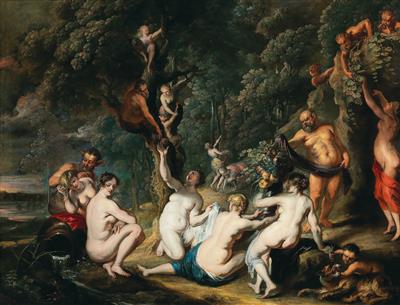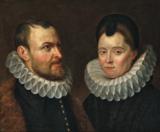Workshop of Peter Paul Rubens

(Siegen 1577–1640 Antwerp)
Nymphs and Satyrs with the Horn of Plenty,
oil on copper, 72.3 x 93.7 cm, framed
The scene depicted in this well preserved painting on copper relates to two stories told by the Roman poet Ovid. In the Fasti (V: 121–24), he writes of a goat that suckled the infant Jupiter, who lost one of the lofty horns that curved over its back. The nymph Amalthea picked up the horn, and carried it to Jove, full of fruit. The invention of the cornucopia, or horn of plenty, is also told by Ovid in his long poem Metamorphoses (IX: 87–88), in which Hercules, in a contest for Deianeira, broke off one of the horns of the river god Achelous. The horn was found by a group of water nymphs, or Naiads, and they filled up that horn with pieces of fruit and fragrant flowers […] and made it sacred. The gracious goddess Abundance uses this, the Cornucopia, as her motif. In this painting, the young and beautiful nymphs occupy the foreground, displaying their round, nude bodies in a variety of engaging poses. In the foreground, two of them hold the cornucopia, its rim overflowing with fruit and vegetables, symbols of the fecundity and abundance of the earth. Behind them, and mingling with the nymphs, are several satyrs. The figure that stands to the right, near the entrance to a cave, may be Pan, the shepherd god from Arcadia who was half-man and half-goat, and likewise associated with fertility. In ancient mythology, nymphs and satyrs often clash, as they embody the opposing forces of chastity and lust. In this image, however, they appear to coexist peacefully, as if embodying the merging of beauty and desire.
Peter Paul Rubens was increasingly fascinated by the pastoral literature of Plato, Homer, Theocritus, Virgil, and Horace during his lifetime, especially in the last decade of his life. This picture was likely inspired by classical texts such as Plato’s Phaedrus, one of the foundational works of the pastoral genre. In it, Plato idealises country life and describes nature as the perfect setting for love. Renaissance painters such as Giorgione and Titian created visual equivalents to similar literary passages and provided the immediate precedents for Rubens’s pastoral landscapes and paintings of nymphs and satyrs.
The first version of this composition (canvas, 139.7 x 167 cm, today Prado, Madrid) was still kept in Rubens’s studio at the time of his death in 1640, which proves that it had not been made in the context of a commission, but rather out of the master’s personal interest in the subject. As early as 1640 it was referred to as ‘A Peice [sic] of Naked Nimphes and Satyrs’ in the inventory of Rubens’s studio, and King Philip IV acquired it from the artist’s estate for his summer apartment at the Alcázar. The workshop versions painted during Rubens’s lifetime demonstrate the artistic importance that the master himself attached to this composition.
The present painting would appear to be a studio variant after Rubens prime version. It has not been possible to identify the artist.
Expert: Dr. Alexander Strasoldo
 Dr. Alexander Strasoldo
Dr. Alexander Strasoldo
+43 1 515 60 403
oldmasters@dorotheum.com
09.06.2020 - 16:00
- Dosažená cena: **
-
EUR 54.902,-
- Odhadní cena:
-
EUR 20.000,- do EUR 30.000,-
Workshop of Peter Paul Rubens
(Siegen 1577–1640 Antwerp)
Nymphs and Satyrs with the Horn of Plenty,
oil on copper, 72.3 x 93.7 cm, framed
The scene depicted in this well preserved painting on copper relates to two stories told by the Roman poet Ovid. In the Fasti (V: 121–24), he writes of a goat that suckled the infant Jupiter, who lost one of the lofty horns that curved over its back. The nymph Amalthea picked up the horn, and carried it to Jove, full of fruit. The invention of the cornucopia, or horn of plenty, is also told by Ovid in his long poem Metamorphoses (IX: 87–88), in which Hercules, in a contest for Deianeira, broke off one of the horns of the river god Achelous. The horn was found by a group of water nymphs, or Naiads, and they filled up that horn with pieces of fruit and fragrant flowers […] and made it sacred. The gracious goddess Abundance uses this, the Cornucopia, as her motif. In this painting, the young and beautiful nymphs occupy the foreground, displaying their round, nude bodies in a variety of engaging poses. In the foreground, two of them hold the cornucopia, its rim overflowing with fruit and vegetables, symbols of the fecundity and abundance of the earth. Behind them, and mingling with the nymphs, are several satyrs. The figure that stands to the right, near the entrance to a cave, may be Pan, the shepherd god from Arcadia who was half-man and half-goat, and likewise associated with fertility. In ancient mythology, nymphs and satyrs often clash, as they embody the opposing forces of chastity and lust. In this image, however, they appear to coexist peacefully, as if embodying the merging of beauty and desire.
Peter Paul Rubens was increasingly fascinated by the pastoral literature of Plato, Homer, Theocritus, Virgil, and Horace during his lifetime, especially in the last decade of his life. This picture was likely inspired by classical texts such as Plato’s Phaedrus, one of the foundational works of the pastoral genre. In it, Plato idealises country life and describes nature as the perfect setting for love. Renaissance painters such as Giorgione and Titian created visual equivalents to similar literary passages and provided the immediate precedents for Rubens’s pastoral landscapes and paintings of nymphs and satyrs.
The first version of this composition (canvas, 139.7 x 167 cm, today Prado, Madrid) was still kept in Rubens’s studio at the time of his death in 1640, which proves that it had not been made in the context of a commission, but rather out of the master’s personal interest in the subject. As early as 1640 it was referred to as ‘A Peice [sic] of Naked Nimphes and Satyrs’ in the inventory of Rubens’s studio, and King Philip IV acquired it from the artist’s estate for his summer apartment at the Alcázar. The workshop versions painted during Rubens’s lifetime demonstrate the artistic importance that the master himself attached to this composition.
The present painting would appear to be a studio variant after Rubens prime version. It has not been possible to identify the artist.
Expert: Dr. Alexander Strasoldo
 Dr. Alexander Strasoldo
Dr. Alexander Strasoldo
+43 1 515 60 403
oldmasters@dorotheum.com
|
Horká linka kupujících
Po-Pá: 10.00 - 17.00
old.masters@dorotheum.at +43 1 515 60 403 |
| Aukce: | Obrazy starých mistrů |
| Typ aukce: | Salónní aukce |
| Datum: | 09.06.2020 - 16:00 |
| Místo konání aukce: | Wien | Palais Dorotheum |
| Prohlídka: | 02.06. - 09.06.2020 |
** Kupní cena vč. poplatku kupujícího a DPH(Země dodání Rakousko)
Není již možné podávat příkazy ke koupi přes internet. Aukce se právě připravuje resp. byla již uskutečněna.
Další objekty umělce
-

Odhadní cena:
EUR 10.000,- do EUR 15.000,-
Všechny objekty umělce
